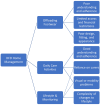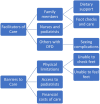Perceptions of Australians with diabetes-related foot disease on requirements for effective secondary prevention
- PMID: 37092611
- PMCID: PMC10947538
- DOI: 10.1111/ajr.12989
Perceptions of Australians with diabetes-related foot disease on requirements for effective secondary prevention
Abstract
Introduction: Secondary prevention is essential in reducing recurrence of diabetes-related foot disease (DFD) but is frequently poorly implemented in clinical practice.
Objective: To explore the perceptions of people with diabetes-related foot disease (DFD) on their self-perceived knowledge in managing DFD, facilitators and barriers influencing their DFD care, and ideas and preferences for a secondary prevention program.
Design: Sixteen people with a history of DFD from Queensland and Victoria, Australia, underwent semi-structured interviews. Interviews were audio-recorded over telephone and transcribed and analysed following a thematic framework. Participants were asked about their experiences and perceptions relating to DFD and factors influencing the care they receive for DFD relevant to the development of a secondary prevention program for DFD.
Findings and discussion: Participants had high self-perceived knowledge in managing DFD, especially in implementing healthy lifestyle changes and conducting daily foot checks and foot care, though most received support from family members acting as carers. However, issues with access and adherence to offloading footwear, and a lack of clear education received on footwear and other aspects of DFD care were perceived as major barriers. Improved patient education, provided in a consistent manner by proactive clinicians was perceived as an essential part of secondary prevention. Telehealth was perceived positively through facilitating faster care and considered a good adjunct to standard care. Health and technological literacy were considered potentially major barriers to the effectiveness of remote care.
Conclusion: People with DFD require improved access to offloading footwear and education about secondary prevention, which could be provided by telehealth with adequate support.
Keywords: diabetes; offloading footwear; patient education; peripheral artery disease; qualitative research; secondary care; telehealth.
© 2023 The Authors. Australian Journal of Rural Health published by John Wiley & Sons Australia, Ltd on behalf of National Rural Health Alliance Ltd.
Conflict of interest statement
The authors declare that there are no conflicts of interest.
Figures




Similar articles
-
Health Professionals' Opinions About Secondary Prevention of Diabetes-Related Foot Disease.Int J Low Extrem Wounds. 2025 Jun;24(2):415-425. doi: 10.1177/15347346221099798. Epub 2022 May 16. Int J Low Extrem Wounds. 2025. PMID: 35578540
-
Patient Perspectives on the Burden and Prevention of Diabetes-Related Foot Disease.Sci Diabetes Self Manag Care. 2023 Jun;49(3):217-228. doi: 10.1177/26350106231170531. Epub 2023 Apr 28. Sci Diabetes Self Manag Care. 2023. PMID: 37114642
-
Health Professionals' Opinions About Secondary Prevention of Diabetes-Related Foot Disease.Sci Diabetes Self Manag Care. 2022 Oct;48(5):349-361. doi: 10.1177/26350106221112115. Epub 2022 Jul 15. Sci Diabetes Self Manag Care. 2022. PMID: 35837980
-
The Potential Role of Sensors, Wearables and Telehealth in the Remote Management of Diabetes-Related Foot Disease.Sensors (Basel). 2020 Aug 13;20(16):4527. doi: 10.3390/s20164527. Sensors (Basel). 2020. PMID: 32823514 Free PMC article. Review.
-
A Review on Newer Interventions for the Prevention of Diabetic Foot Disease.Cureus. 2022 Oct 22;14(10):e30591. doi: 10.7759/cureus.30591. eCollection 2022 Oct. Cureus. 2022. PMID: 36426316 Free PMC article. Review.
Cited by
-
Outcomes of Revascularisation for Treating Lifestyle-Limiting Intermittent Claudication in Aboriginal and Torres Strait Islander People and Non-Indigenous Patients from North Queensland: A Retrospective Cohort Study.J Clin Med. 2024 Jun 5;13(11):3339. doi: 10.3390/jcm13113339. J Clin Med. 2024. PMID: 38893050 Free PMC article.
-
Association of remoteness and ethnicity with major amputation following minor amputation to treat diabetes-related foot disease.PLoS One. 2024 Jul 5;19(7):e0302186. doi: 10.1371/journal.pone.0302186. eCollection 2024. PLoS One. 2024. PMID: 38968185 Free PMC article.
-
Determinants of Foot Care Adherence Among High-Risk Diabetic Populations: Insights From an Ethnic Minority Community Study in Southwest China.J Prim Care Community Health. 2025 Jan-Dec;16:21501319251347877. doi: 10.1177/21501319251347877. Epub 2025 Jul 9. J Prim Care Community Health. 2025. PMID: 40635313 Free PMC article.
References
MeSH terms
Supplementary concepts
Grants and funding
LinkOut - more resources
Full Text Sources
Medical

